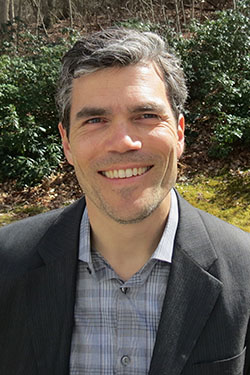Derek Turner, Connecticut College – How Science Connects Us To Places
 On Connecticut College Week: To find meaning, look into history.
On Connecticut College Week: To find meaning, look into history.
Derek Turner, professor of philosophy, discusses how learning history can change our feelings about a thing or place.
Derek Turner regularly teaches Introduction to Philosophy, Logic, Bioethics, Environmental Philosophy, Philosophy of Science, Philosophy of Biology, The Science and Ethics of Extinction, and Darwin. He also enjoys teaching courses on the history of philosophy. In the fall of 2016, he taught a new ConnCourse on The Meaning of Dinosaurs.
A past winner of the John S. King Award for Excellence in Teaching, Turner is Associate Director of the College’s Goodwin-Niering Center for the Environment. He was awarded the 2017 Nancy Batson Nisbet Rash Faculty Award for Excellence in Research.
Turner’s research focuses on philosophical issues in historical science, especially paleontology and the earth sciences. He is interested in understanding how scientists come to know things about the deep past. Some of his recent work explores the big ideas of macroevolutonary theory: historical contingency, evolutionary stasis, species selection, and the study of large-scale evolutionary trends. He is the author of Making Prehistory: Historical Science and the Scientific Realism Debate (2007) and Paleontology: A Philosophical Introduction (2011).
He has also written on a variety of topics in environmental philosophy: the ethics of radical environmental activism; the precautionary principle; NIMBY (“Not In My Backyard”) activism; as well as rewilding and de-extinction. The NIMBY project was a joint effort with Simon Feldman.
Turner has had visiting fellowships at the University of Pittsburgh’s Center for Philosophy of Science and most recently at the KLI in Klosterneuburg, Austria.
He is also a founding editor and contributor to a new blog for philosophy of paleontology: Extinct.
How Science Connects Us To Places
Some 430 million years ago, a chunk of land called Avalonia completed an amazing geological journey. After breaking off from a much bigger landmass, it drifted northward for tens of millions of years, and then collided with the continent that we now know as North America. Today, there is a geologically distinctive sliver of the Earth’s crust running from southeastern Connecticut to the Canadian maritime provinces that was once part of Avalonia.
This is a remarkable story, and one question that philosophers of science ask is how scientists can figure out what happened so far back in the deep past.
Historical science is not just about knowledge, though.
Historical sciences like geology also have an important aesthetic side. This aesthetic side has to do with our experience of places, and landscapes.
Think about how learning about the history of a thing can affect our relationship to it, and change how we appreciate it. You might see an item for sale in an antique shop and think nothing of it. But if you learned that the item once belonged to someone you care about, that would change how you think about it, how you value it, and how you experience it. In our aesthetic engagement with things around us, the past is always present.
This, in turn, should bear on how we think about historical science. Investigating the deep history of places is not only about gaining knowledge—though it is about that—but it is also a way of cultivating sense of place. Science itself is a way of enriching our aesthetic engagement with landscapes, and a way of bettering our relationships to places.


